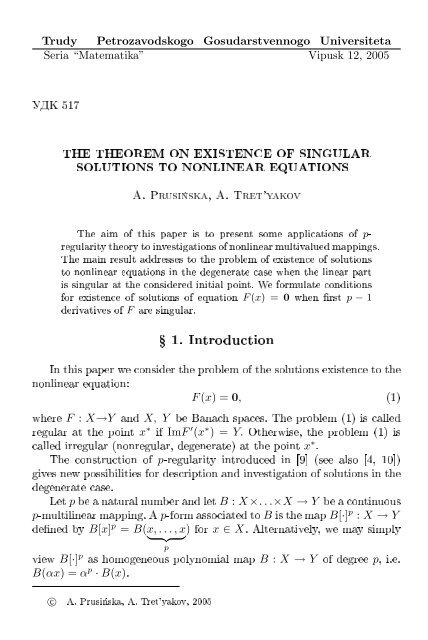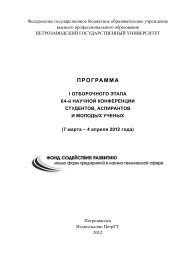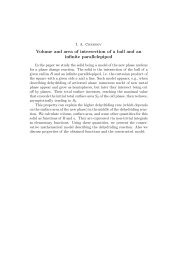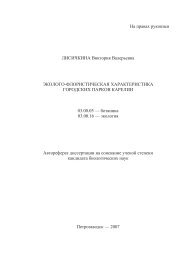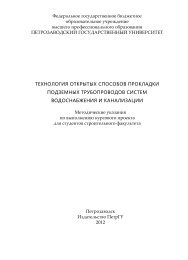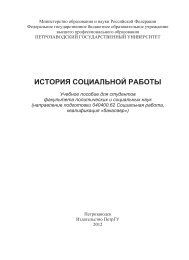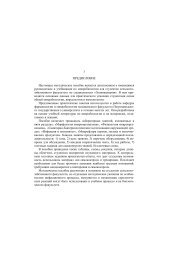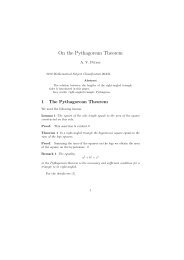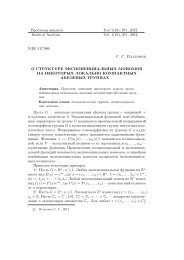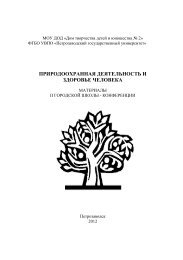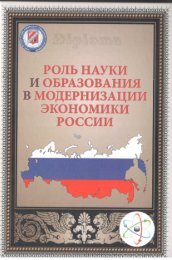Ñ 1. Introduction - Issues of Analysis
Ñ 1. Introduction - Issues of Analysis
Ñ 1. Introduction - Issues of Analysis
Create successful ePaper yourself
Turn your PDF publications into a flip-book with our unique Google optimized e-Paper software.
Trudy Petrozavodskogo Gosudarstvennogo UniversitetaSeria “Matematika” Vipusk 12, 2005ÓÄÊ 517THE THEOREM ON EXISTENCE OF SINGULARSOLUTIONS TO NONLINEAR EQUATIONSA. Prusinska, A. Tret'yakovThe aim <strong>of</strong> this paper is to present some applications <strong>of</strong> p-regularity theory to investigations <strong>of</strong> nonlinear multivalued mappings.The main result addresses to the problem <strong>of</strong> existence <strong>of</strong> solutionsto nonlinear equations in the degenerate case when the linear partis singular at the considered initial point. We formulate conditionsfor existence <strong>of</strong> solutions <strong>of</strong> equation F (x) = 0 when rst p − 1derivatives <strong>of</strong> F are singular.Ÿ <strong>1.</strong> <strong>Introduction</strong>In this paper we consider the problem <strong>of</strong> the solutions existence to thenonlinear equation:F (x) = 0, (1)where F : X→Y and X, Y be Banach spaces. The problem (1) is calledregular at the point x ∗ if ImF ′ (x ∗ ) = Y. Otherwise, the problem (1) iscalled irregular (nonregular, degenerate) at the point x ∗ .The construction <strong>of</strong> p-regularity introduced in [9] (see also [4, 10])gives new possibilities for description and investigation <strong>of</strong> solutions in thedegenerate case.Let p be a natural number and let B : X ×. . .×X → Y be a continuousp-multilinear mapping. A p-form associated to B is the map B[·] p : X → Ydened by B[x] p = B(x, . . . , x) for x ∈ X. Alternatively, we may simply} {{ }pview B[·] p as homogeneous polynomial map B : X → Y <strong>of</strong> degree p, i.e.B(αx) = α p · B(x).c○ A. Prusinska, A. Tret'yakov, 2005
The theorem on existence <strong>of</strong> singular solutions 23Throughout this paper we assume that the mapping F : X → Yis continuous and p-times Frechet dierentiable on X and its p-th orderderivative at point x ∈ X will be denoted as F (p) (x) (a symmetricmultilinear map <strong>of</strong> p copies <strong>of</strong> X to Y ) and the associated p-form isF (p) (x)[h] p = F (p) (x)[h, . . . , h].} {{ }pFurthermore, we use the following notationKer p F (p) (x) ={}h ∈ X : F (p) (x)[h] p = 0for the p-kernel <strong>of</strong> the mapping F (p) (x) (the zero locus <strong>of</strong> F (p) (x)). Denotealso L(X, Y ) as a space <strong>of</strong> continuous linear operators from X to Y .The setM(x ∗ ) = {x ∈ U : F (x) = F (x ∗ )}is called the solution set for the mapping F in neighborhood U.We call h a tangent vector to a set M ⊆ X at x ∗ ∈ M if there existε > 0 and a function r : [0, ε] → X with the property that for t ∈ [0, ε],we have x ∗ + th + r(t) ∈ M and‖r(t)‖lim = 0.t→0 tThe collection <strong>of</strong> all tangent vectors at x ∗ is called the tangent cone to Mat x ∗ and it is denoted by T 1 M(x ∗ ) (see e. g. [1]).Let X and Y be sets. We denote by 2 Y the set <strong>of</strong> all subsets <strong>of</strong> the setY . Any mapping Φ : X→2 Y is said to be multimapping (or a multivaluedmapping) from X into Y . For a linear operator Λ : X → Y, we denote byΛ −1 its right inverse, that is Λ −1 : Y → 2 X , which any element y ∈ Ymaps on its complete inverse image at the mapping Λ :Λ −1 y = {x ∈ X : Λx = y} .Of course,ΛΛ −1 = I Y .Furthermore, we shall use the "norm"∥ Λ−1 ∥ ∥ = sup‖y‖=1inf {‖x‖ : Λx = y, x ∈ X} . (2)
24 A. Prusinska, A. Tret'yakovNote, that when Λ is one-to-one, ‖Λ −1 ‖ can be considered as the usualnorm <strong>of</strong> the element Λ −1 in the space L(Y, X).In our further considerations, under notion Λ −1 we shall mean justright inverse operator (multivalued) with the norm dened by (2). Moreover,unless otherwise stated we will assume that X and Y are Banachspaces.Ÿ 2. Elements <strong>of</strong> p-regularity theoryLet U be a neighborhood <strong>of</strong> a point x ∗ ∈ X. If F : U → Y is p-timesdierentiable mapping in U andF (i) (x ∗ ) = 0, for all i = 1, . . . , p − 1,then we say that F is completely degenerate at x ∗ up to order p.A mapping F is called regular at some point x ∗ ifImF ′ (x ∗ ) = Y. (3)The mapping F is called nonregular (irregular, degenerate) if regularitycondition is not satised.In this paper we consider the case when the regularity condition (3)does not hold, but the mapping F is p-regular. First <strong>of</strong> all, let us remindthe denition <strong>of</strong> p-regularity and construction <strong>of</strong> p-factor-operator.Definition <strong>1.</strong> Let F : U → Y, U ⊆ X, and F ∈ C p (U). Then forany x ∈ U and for any element h ∈ X, h ≠ 0 we can associate a linearoperator F (p) (x)[h] p−1 ∈ L(X, Y ), dened by the formula:The linear operatorF (p) (x)[h] p−1 ξ = F (p) (x)[h] p−1 [ξ], for any ξ ∈ X.Ψ p (x, h) = F (p) (x)[h] p−1 ∈ L(X, Y )is called the p-factor operator.A generalization <strong>of</strong> the regularity condition is given by the followingcondition <strong>of</strong> p-regularity:
The theorem on existence <strong>of</strong> singular solutions 25Definition 2. Let F : U → Y , U ⊆ X where F ∈ C p (U) and iscompletely degenerate at x ∗ . Then F is called p-regular at the point x ∗ ifeitherImΨ p (x ∗ , h) = Y, for any h ∈ Ker p F (p) (x ∗ ) \ {0},or Ker p F (p) (x ∗ ) = {0}.Definition 3. We say that the mapping F is p-regular at x ∗ along (on)the element h, if ImΨ p (x 0 , h) = Y.The description <strong>of</strong> a solution set in degenerate case is given by thefollowing theorem:Theorem (Generalized Lyusternik Theorem) [9] Let U be aneighborhood <strong>of</strong> a point x ∗ ∈ X. Assume that F : X→Y, where F ∈ C p (U)is p-regular at x ∗ . ThenT 1 M(x ∗ ) = Ker p F (p) (x ∗ ).Let Z be a metric space with distance ρ. If A 1 ⊂ Z and A 2 ⊂ Z, thenthe numberσ(A 1 , A 2 ) = supz∈A 1ρ(z, A 2 ) = supz∈A 1inf ρ(z, ω)ω∈A 2is called the deviation <strong>of</strong> the set A 1 from the set A 2 . The maximum <strong>of</strong> thedeviations σ(A 1 , A 2 ) and σ(A 2 , A 1 ),h(A 1 , A 2 ) = max {σ(A 1 , A 2 ), σ(A 2 , A 1 )} ,is called the Hausdor distance between the sets A 1 and A 2 . It follows atonce from the denition that, if h(A 1 , A 2 ) < α, then, for every z 1 ∈ A 1 ,there exists a z 2 ∈ A 2 such that ρ(z 1 , z 2 ) < α.Let Φ be a multimapping from the space Z into itself. We shall saythat it is a contraction on a set A ⊂ Z if there exists a number θ with0 < θ < 1 such that the inequalityholds for any z 1 and z 2 from A.h(Φ(z 1 ), Φ(z 2 )) ≤ θρ(z 1 , z 2 )
26 A. Prusinska, A. Tret'yakovWe shall give three auxiliary lemmas. The rst <strong>of</strong> these lemmas is a"multivalued"generalization <strong>of</strong> the contraction mapping principle, and isindependent interest.Lemma <strong>1.</strong> (contraction multimapping principle) [3] Let Z be acomplete metric space with distance ρ. Assume that we are given a multimappingΦ : U ε (z 0 ) → 2 Z ,on a ball U ε (z 0 ) = {z : ρ(z, z 0 ) < ε} (ε > 0) where the sets Φ(z) are nonemptyand closed for any z ∈ U ε (z 0 ). Further, assume that there exists anumber θ, 0 < θ < 1, such that1) h(Φ(z 1 ), Φ(z 2 )) ≤ θρ(z 1 , z 2 ) for any z 1 , z 2 ∈ U ε (z 0 ),2) ρ(z 0 , Φ(z 0 )) < (1 − θ)ε.Then, for every number ε 1 which satises the inequalityρ(z 0 , Φ(z 0 )) < ε 1 < (1 − θ)ε,there exists an element z ∈ B ε1 /(1−θ)(z 0 ) = {ω : ρ(ω, z 0 ) ≤ ε 1 /(1 − θ)}such thatz ∈ Φ(z) (4)Lemma 2. [3] Let M 1 and M 2 be linear manifolds in X which are translations<strong>of</strong> a single subspace L. Thenh(M 1 , M 2 ) = σ(M 1 , M 2 ) = σ(M 2 , M 1 ) == inf {‖x 1 − x 2 ‖ : x 1 ∈ M 1 , x 2 ∈ M 2 } .Lemma 3. [3] Let Λ ∈ L(X, Y ). We setIf ImΛ = Y, then C(Λ) < ∞.C(Λ) = sup inf {‖x‖ : x ∈ X, Λx = y} .‖y‖=1Ÿ 3. Regular caseWe quote one modication <strong>of</strong> the theorem on existence <strong>of</strong> solutions tothe equations with non-degenerate mappings (see in [2, 5, 6]) with pro<strong>of</strong>
The theorem on existence <strong>of</strong> singular solutions 27which the main idea is based on the similar construction to this in singularcase.Consider a mapping F : X → Y and the problem <strong>of</strong> existence <strong>of</strong> suchpoint x ∗ that F (x ∗ ) = 0, i.e. x ∗ is a solution <strong>of</strong> (1). This equation is solvedby using non-degenerated condition <strong>of</strong> operator F ′ (x). Throughout thissection we assume that [F ′ (x 0 )] −1 is the multivalued mapping, and thatF ′ (x 0 ) is nonsingular, i.e. F ′ (x 0 )X = Y.Theorem <strong>1.</strong> Let ‖F (x 0 )‖ = η and ∥ ∥[F ′ (x 0 )] −1∥ ∥ = δ, and assumethatsup ‖F ′′ (x)‖ = C,x∈U ε (x 0 )where F ∈ C 2 (U ε (x 0 )). Moreover, assume the following inequalities:1) δ · C · ε ≤ 6,12) δ · η ≤ 2,ε3) ε ≤ <strong>1.</strong>Then the equation F (x) = 0 has a solution x ∗ ∈ U ε (x 0 ).Pro<strong>of</strong>. Dene a multivalued mappingΨ : U ε (x 0 ) → 2 X ,U ε (x 0 ) ⊂ XΨ(x) = x − [F ′ (x 0 )] −1 F (x), x ∈ U ε (x 0 ).We shall show now that there exists a number q, 0 < q < 1, such thatfor any s 1 , s 2 ∈ U ε (x 0 ).By Lemma 2 and Lemma 3, we haveh(Ψ(s 1 ), Ψ(s 2 )) ≤ q · ‖s 1 − s 2 ‖, (5)h(Ψ(s 1 ), Ψ(s 2 )) = inf {‖z 1 − z 2 ‖ : z i ∈ Ψ(s i ), i = 1, 2} == inf {‖z 1 − z 2 ‖ : F ′ (x 0 )z i = F ′ (x 0 )s i − F (s i ), i = 1, 2} == inf {‖z‖ : F ′ (x 0 )z = F ′ (x 0 )[s 1 − s 2 ] − F (s 1 ) + F (s 2 )} == δ · ‖F (s 1 ) − F (s 2 ) − F ′ (x 0 ) · [s 1 − s 2 ]‖ .From the Taylor expansion <strong>of</strong> F, we haveF (s 1 ) − F (s 2 ) = F ′ (s 2 )[s 1 − s 2 ] + ω(s 1 , s 2 ),
28 A. Prusinska, A. Tret'yakovwhereand moreover‖ω(s 1 , s 2 )‖ ≤∥sup ∥F ′′ (x)[s 1 − s 2 ] 2∥ ∥ ≤ C · ‖s 1 − s 2 ‖ 2 ,x∈U ε (x 0 )whereF ′ (s 2 ) = F ′ (x 0 ) + ξ(s 2 , x 0 ),‖ξ(s 2 , x 0 )‖ ≤sup ‖F ′′ (x)[s 2 − x 0 ]‖ ≤ C · ‖s 2 − x 0 ‖.x∈U ε (x 0 )Taking into account the above and the assumption 1 we obtainh(Ψ(s 1 ), Ψ(s 2 )) = δ · ‖ξ(s 2 , x 0 )[s 1 − s 2 ] + ω(s 1 , s 2 )‖ ≤Now, we claim thatIndeed,≤ δ · (‖ξ(s 2 , x 0 )‖ · ‖s 1 − s 2 ‖ + ‖ω(s 1 , s 2 )‖) ≤≤ δ · (C· ‖s 2 − x 0 ‖ · ‖s 1 − s 2 ‖ + C · ‖s 1 − s 2 ‖ 2)
The theorem on existence <strong>of</strong> singular solutions 29We conclude the discussion <strong>of</strong> the regular case by the following example,which is very simple, but serves to illustrate the basic idea <strong>of</strong> Theorem <strong>1.</strong>Example. Consider the problem (1) with (x 0 , y 0 ) = (0, 0) andF : R 2 → R,where F (x, y) = x 3 + x − y + 11100. Moreover, ‖F (0, 0)‖ = η =100 ,√ ∥ [F ′ (0, 0)] −1∥ ∥ 2 = δ =2 , sup ‖F ′′ (x, y)‖ ≤ C = 6 · ε,(x,y)∈U ε (0,0)where ε = 0, <strong>1.</strong> The assumptions <strong>of</strong> Theorem 1 are fullled, so there existssuch point (x ∗ , y ∗ ), that F (x ∗ , y ∗ ) = 0, and for instance (x ∗ , y ∗ ) = (0,1100 ).Ÿ 4. p-regular (singular) caseLet us mention one <strong>of</strong> the consequences <strong>of</strong> the Mean Value Theorem,which is important for our further investigations. For the pro<strong>of</strong> we referthe reader to [7, 8].Lemma 4. Let F : U → Y, where U ⊆ X, such that [a, b] ⊂ U, then‖F (b) − F (a) − Λ(b − a)‖ ≤ sup ‖F ′ (ξ) − Λ‖ · ‖a − b‖,ξ∈[a,b]for any Λ ∈ L(X, Y ).Next lemma follows from homogeneity properties <strong>of</strong> p-form (see [4]).Lemma 5. [4] Let U(x 0 ) neighborhood <strong>of</strong> x 0 in X, F : U(x 0 ) → Y,F ∈ C p+1 (U(x 0 )), and F (i) (x 0 ) = 0, for i = 1, . . . , p − <strong>1.</strong> Then for every(R = max{1, 2 ɛ · 1(p−1)!∥∥F (p) (x 0 ) ∥ })ɛ > 0 there exist δ > 0 and R > 0such that for any x ∈ X, ‖x‖ ≤ δ and for any x 1 , x 2 ∈ X, ‖x j ‖ ≤‖x‖/R, j = 1, 2, the following condition∥ F (x 10 + x + x 1 ) − F (x 0 + x + x 2 ) −(p − 1)! F (p) (x 0 )[x] p−1 (x 1 − x 2 )∥ ≤≤ ɛ · ‖x‖ p−1 · ‖x 1 − x 2 ‖ holds.Definition 4. (Banach condition) Let F : X → Y, and let F ∈C p (X). Then for any y ∈ Y, ‖y‖ = 1 there exists x ∈ X, such thatF (p) (x 0 )[x] p = y, ‖x‖ ≤ c,
30 A. Prusinska, A. Tret'yakovwhere c > 0 is a constant independent <strong>of</strong> y.Let us introduce following additional notationsĥ =δ = ‖F (x 0 )‖ ̸= 0,{ [ h‖h‖ , where ] −1 1 h ∈ p! F (p) (x 0 ) (−F (x 0 ))}, h ≠ 0,as a generalization <strong>of</strong> (2) we have[η =∥F (p) (x 0 )] −1∥ ∥∥∥= sup‖y‖=1C ={}inf ‖x‖ : F (p) (x 0 )[x] p = y, x ∈ X ,supx∈U ε (x 0 )∥∥F (p+1) (x) ∥ ,[∥C 1 =∥ F (p) (x 0 )[ĥ]p−1] −1 ∥∥and∥C 2 = ∥F (p) (x 0 ) ∥ .We can now formulate our main result which is a generalization <strong>of</strong> Theorem 1in the degenerate case.Theorem 2. Let F : X → Y and assume that for F ∈ C p+1 (U ε (x 0 ))the Banach condition holds and F is p-regular mapping at the point x 0along ĥ and F (i) (x 0 ) = 0, for i = 1, . . . , p − <strong>1.</strong> Moreover assume thefollowing inequalities1) p! · η · δ 1 p ≤ε2 ,2) 4 p · (p − 1)! · C · C 1 · ε ≤ 1 2 ,3) ε < <strong>1.</strong>Then the equation F (x) = 0 has a solution x ∗ ∈ U ε (x 0 ).Äîêàçàòåëüñòâî.As in the pro<strong>of</strong> <strong>of</strong> Theorem 1 consider a multivalued mappingΨ : U ε (x 0 ) → 2 X , U ε (x 0 ) ⊂ X,
The theorem on existence <strong>of</strong> singular solutions 31[] −11Ψ(x) = x −(p − 1)! F (p) (x 0 )[h] p−1 [F (x)], x ∈ U ε (x 0 ).Let us rst prove that there exists a number q, 0 < q < 1, such thath(Ψ(s 1 ), Ψ(s 2 )) ≤ q · ‖s 1 − s 2 ‖, (7)for any s 1 , s 2 ∈ U ε (x 0 ), such that s 1 = x 0 + h + u 1 , s 2 = x 0 + h + u 2 ,where ‖u i ‖ ≤ ‖h‖R , i = 1, 2 and {R = max 21,ε·C · ∥1(p−1)!∥F (p) (x 0 ) ∥ } .By Lemmas 2 and 3, we haveh(Ψ(s 1 ), Ψ(s 2 )) = inf {‖z 1 − z 2 ‖ : z i ∈ Ψ(s i ), i = 1, 2} === inf{‖z 1 − z 2 ‖ :1(p − 1)! F (p) (x 0 )[h] p−1 [z i ] =1(p − 1)! F (p) (x 0 )[h] p−1 [s i ] − F (s i ), i = 1, 2} ≤≤ inf{‖z‖ :1(p − 1)! F (p) (x 0 )[h] p−1 [z]1=(p − 1)! F (p) (x 0 )[h] p−1 [s 1 − s 2 ] − F (s 1 ) + F (s 2 )} ≤(p − 1)!≤‖h‖ p−1 C 1 ·∥ F (s 11) − F (s 2 ) −(p − 1)! F (p) (x 0 )[h] p−1 [s 1 − s 2 ]∥ .Further, taking into account Lemma 4, we have≤ supθ∈[0,1]∥ F (s 11) − F (s 2 ) −(p − 1)! F (p) (x 0 )[h] p−1 [s 1 − s 2 ]∥ ≤∥ F ′ (s 2 + θ(s 1 − s 2 )) −From the Taylor expansion, we obtain1(p − 1)! F (p) (x 0 )[h] p−1 ∥ ∥∥∥· ‖s 1 − s 2 ‖ . (8)F ′ (s 2 + θ(s 1 − s 2 )) = F ′ (x 0 ) + . . . ++ 1(p−1)! F (p) (x 0 )[s 2 − x 0 + θ(s 1 − s 2 )] p−1 + ω(h, u 1 , u 2 , θ) == 1(p−1)! F (p) (x 0 )[s 2 − x 0 + θ(s 1 − s 2 )] p−1 + ω(h, u 1 , u 2 , θ), (9)
32 A. Prusinska, A. Tret'yakovwhere‖ω(h, u 1 , u 2 , θ)‖ ≤supx∈U ε (x 0 )On account <strong>of</strong> R and ‖u i ‖, i = 1, 2, we have∥∥∥F (p+1) (x)[h + u 2 + θ(s 1 − s 2 )] p ∥∥ .‖h + u 2 + θ(s 1 − s 2 )‖ ≤ 4 · ‖h‖,and from assumption, ‖h‖ ≤ ε 2. By the above,Moreover,‖ω(h, u 1 , u 2 , θ)‖ ≤ C · ‖h‖ p ≤ 4 p · C · ε2 · ‖h‖p−1 . (10)F (p) (x 0 )[h + u 2 + θ(s 1 − s 2 )] p−1 =∑p−1Cp−1F i (p) (x 0 )[h] p−1−i [u 2 + θ(s 1 − s 2 )] i =i=0∑p−1F (p) (x 0 )[h] p−1 +i=1C i p−1F (p) (x 0 )[h] p−1−i [u 2 + θ(s 1 − s 2 )] i , (11)where‖u 2 + θ(s 1 − s 2 )‖ ≤ 3 · ‖h‖/R. (12)Taking into account the choice <strong>of</strong> R,∥ ∑p−1∥∥∥∥ C i∥p−1F (p) (x 0 )[h] p−1−i [u 2 + θ(s 1 − s 2 )] i ≤i=1∥≤ ∥F (p) ∑p−1(x 0 ) ∥ · Cp−1‖h‖ i p−1−i (3 · ‖h‖) i /R i ≤i=1∥≤ ∥F (p) (x 0 ) ∥ · ‖h‖ p−1 · 4 p−1 /R ≤ 4 p · (p − 1)! · ε2 · C · ‖h‖p−1 . (13)And nally, applying (9)(13) in (8) we obtain∥ F (s 11) − F (s 2 ) −(p − 1)! F (p) (x 0 )[h] p−1 · [s 1 − s 2 ]∥ ≤≤ 4 p · ε · C · ‖h‖ p−1 · ‖s 1 − s 2 ‖.
The theorem on existence <strong>of</strong> singular solutions 33Henceh(Ψ(s 1 ), Ψ(s 2 )) ≤(p − 1)!‖h‖ p−1 · 4p · C · C 1 · ε · ‖h‖ p−1 · ‖s 1 − s 2 ‖ == 4 p · (p − 1)! · C · C 1 · ε · ‖s 1 − s 2 ‖ ≤ q · ‖s 1 − s 2 ‖, where q = 1 2 .Letx 1 ∈ x 0 −[ 1p! F (p) (x 0 )] −1(F (x 0 )) (14)Thus this element x 1 is such that ‖x 1 − x 0 ‖ ≤ ε 2 . Indeed,[ ] ∥ −1 1 ∥∥∥∥‖x 1 − x 0 ‖ ≤∥ p! F (p) (x 0 ) · ‖F (x 0 )‖ 1 1 εp ≤ p! · δp · η ≤2 ,so x 1 ∈ U ε (x 0 ). We have to verify thatρ(Ψ(x 1 ), x 1 ) < (1 − q) · ε,where q = 1 2 . So ρ(Ψ(x 1 ), x 1 ) = inf {‖z‖ : z ∈ Ψ(x 1 ) − x 1 } ={[] }−11= inf ‖z‖ : z ∈ x 1 −(p − 1)! F (p) (x 0 )[h] p−1 F (x 1 ) − x 1 ={ [] }−11= inf ‖z‖ :(p − 1)! F (p) (x 0 )[h] p−1 z = −F (x 1 ) ≤(p − 1)!‖h‖ p−1 · C 1 · ‖F (x 1 )‖.From the Taylor expansion <strong>of</strong> F (x 1 ) and under an assumption <strong>of</strong> completedegeneration <strong>of</strong> F:whereF (x 1 ) = F (x 0 ) + F (p) (x 0 )[x 1 − x 0 ] p + ω 1 (x 1 , x 0 ),p!‖ω 1 (x 1 , x 0 )‖ ≤supx∈U ε(x 0)∥∥∥F (p+1) (x)[h] p+1 ∥∥ ≤ C · ‖h‖ p+1 ,
34 A. Prusinska, A. Tret'yakov[−11and x 1 − x 0 ∈p! F (p) (x 0 )](−F (x0 )), hence 1 p! F (p) (x 0 )[x 1 − x 0 ] p =−F (x 0 ), we nally obtain:(p − 1)!ρ(Ψ(x 1 ), x 1 ) ≤‖h‖ p−1 ·C 1·∥ F (x 0) + F (p) (x 0 )[x 1 − x 0 ] p + ω 1 (x 1 , x 0 )p!∥ =≤=(p − 1)!‖h‖ p−1 · C 1 · ‖F (x 0 ) − F (x 0 ) + ω 1 (x 1 , x 0 )‖ ≤≤(p − 1)!‖h‖ p−1 · C 1 · C · ‖ω 1 (x 1 , x 0 )‖ ≤(p − 1)!‖h‖ p−1 · C 1 · C · ‖h‖ p+1 ≤ (p − 1)! · C 1 · C · ‖x 1 − x 0 ‖ 2 ≤≤ (p − 1)! · C · C 1 · ε24 = 1 8 · ε.It follows that all conditions <strong>of</strong> Lemma 1 and inclusion (4), so there existsan element x ∗ such that x ∗ ∈ Ψ(x ∗ ). It means thathence[] −1x ∗ ∈ x ∗ 1+(p − 1)! F (p) (x 0 )[h] p−1 (−F (x ∗ )),[] −110 ∈(p − 1)! F (p) (x 0 )[h] p−1 (−F (x ∗ ))and1(p−1)! F (p) (x 0 )[h] p−1 0 = −F (x ∗ ), further 0 = −F (x ∗ ) and nallyF (x ∗ ) = 0. ✷As in regular case we give simple examples illustrating the application<strong>of</strong> Theorem 2. More detailed and pr<strong>of</strong>ound applications we omit withrespect to the limit <strong>of</strong> this paper.Example <strong>1.</strong> Consider situation, where the p-regularity condition isfullled, but the Banach conditionF ′′ (x 0 )[X] 2 = Y (15)does not hold.Namely, let F : R → R, and F (x) = x 2 + ε, where ε > 0. Moreover,if x 0 = 0, and p = 2, we have that F is p-regular at x 0 , but the equation
The theorem on existence <strong>of</strong> singular solutions 35F (x) = 0 has no solution. This follows from the fact that the condition(15) fails.Example 2. Let F : R 2 → R, and F (x, y) = x 2 − y 2 + x 3 + x 7 + 110.Consider the problem (1) with 6 (x 0 , y 0 ) = (0, 0), and p = 2. It is easy toprove that the mapping F is 2-regular at the point (x 0 , y 0 ). Moreover, wehave δ = 1110, h = (0, 6 10), ĥ = (0, 1), η = 1, C = 6 + 3 210ε4 , C 1 = 1 2 ,C 2 = 2ε 2 . All <strong>of</strong> the assumptions <strong>of</strong> the Theorem 2 are fullled. Hencethere exists a solution (x ∗ , y ∗ ) <strong>of</strong> the problem (1), and one <strong>of</strong> such pointsfrom a ε-neighborhood U ε (0), where ε = 1100 , is (0, 110). 3
36 A. Prusinska, A. Tret'yakovÑïèñîê ëèòåðàòóðû[1] Alexeev V. M. Optimal Control / V. M. Alexeev, V. M. Tihomirov, S. V.Fomin. N. Y.: Consultants Bureau, 1987.[2] Demidovitch B. P. Basis <strong>of</strong> Computational Mathematics / B. P.Demidovitch, I. A. Maron. M.: Nauka, 1973. (Russian).[3] Ioe A. D. Theory <strong>of</strong> extremal problems / A. D. Ioe, V. M. Tihomirov.Amsterdam: Studies in Mathematics and its Applications, 1979.[4] Izmailov A. F. Factor-<strong>Analysis</strong> <strong>of</strong> Non-Linear Mapping / A. F. Izmailov,A. A. Tret'yakov. M.: Nauka, 1994. (Russian).[5] Kantorovich L. V. Functional <strong>Analysis</strong> / L. V. Kantorovitch, G. P. Akilov.Oxford: Pergamon Press, 1982.[6] Krasnosel'skii M. A. Approximated Solutions <strong>of</strong> Operator Equations /M. A. Krasnosel'skii, G. M. Wainikko, P. P. Zabreiko, Yu. B. Rutitcki,V. Yu. Stetsenko. Groningen: Walters-Noordho Publishing, 1972.[7] Maurin K. <strong>Analysis</strong>. Part I. Elements / K. Maurin. Warsow: PWN, 197<strong>1.</strong>(Polish).[8] Ortega J. M. Iterative Solution <strong>of</strong> Non-Linear Equations in SeveralVariables / J. M. Ortega, W. C. Reinboldt. N. Y.: Academic Press, 1970.[9] Tret'yakov A. A. Necessary and Sucient Conditions for Optimality <strong>of</strong>p-th Order / A. A. Tret'yakov // USSR Comput. Math. and Math Phys.V. 24. 1984. P. 123127.[10] Tret'yakov A. A. Factor-analysis <strong>of</strong> nonlinear mappings: p-regularity theory/ A. A. Tret'yakov, J. E. Marsden // Communications on Pure and Applied<strong>Analysis</strong>. 2003. V. 2. N 4. P. 425445.A. Prusinska, University <strong>of</strong> Podlasie,Department <strong>of</strong> Natulal Sciences,ul. 3 Maja 54, 08110 Siedlce,PolandE-mail: aprus@ap.siedlce.plA. Tret'yakov, Academy <strong>of</strong> Sciences,System Research Institute,ul. Newelska 6, 01447 WarszawaPoland E-mail: tret@ap.siedlce.plRuusian Academy <strong>of</strong> Sciences, Computing Center,Vavilova 40, Moskow, GSP1, Russia


